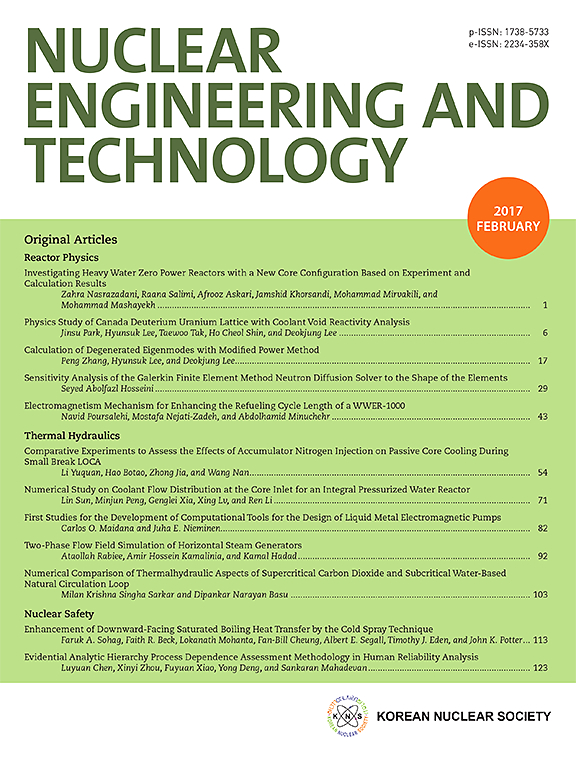具有相同进出口集箱的不同结构螺旋管的密度波振荡研究
IF 2.6
3区 工程技术
Q1 NUCLEAR SCIENCE & TECHNOLOGY
引用次数: 0
摘要
螺旋蒸汽发生器(hsg)具有优良的传热性能和紧凑的设计特点,在小型模块化反应堆的设计中至关重要。这些特点使得高铁可用于轻水和非轻水反应堆。然而,它们带来了重大的设计和操作挑战,特别是在密度波振荡(DWO)等两相流不稳定性方面。DWO产生于螺旋管内复杂的热-水力相互作用,如果不能明确定义稳定边界,可能会对蒸汽发生器和反应堆的安全性和性能产生不利影响。本研究通过对hsg中DWO进行深入的实验和计算分析,以加深对DWO热液特性和机制的理解。重点分析了在两种构型下观察到的DWO特性:两个相同的螺旋管和三个不同几何形状的螺旋管。利用R245fa作为工作流体,设计并建造了一个实验设施,以详细了解两相压降和DWO特性。这些数据进一步用于验证和改进MARS-KS代码,有助于建立代表复杂hsg的稳定性边界。本研究旨在为今后hsg的设计和安全评价提供基础数据。本文章由计算机程序翻译,如有差异,请以英文原文为准。
Investigations of density wave oscillation in helical tubes with different configurations sharing the same inlet and outlet headers
Helical steam generators (HSGs) are crucial in the design of small modular reactors, offering excellent heat transfer performance and compact design characteristics. These features make HSGs viable for both light water and non-light water reactors. However, they pose significant design and operational challenges, particularly with respect to two-phase flow instabilities such as density wave oscillation (DWO). DWO arises from complex thermal-hydraulic interactions within the helical tubes, and failure to clearly define stability boundaries can adversely impact the safety and performance of steam generators and reactor operations. This study provides an in-depth experimental and computational analysis of DWO in HSGs to deepen the understanding of thermal-hydraulic characteristics and DWO mechanisms. The analysis focuses on DWO characteristics observed in two configurations: two identical helical tubes and three helical tubes with differing geometries. An experimental facility utilizing R245fa as the working fluid was designed and constructed to provide detailed insights into two-phase pressure drop and DWO characteristics. The data were further used for the validation and improvement of the MARS-KS code, contributing to the establishment of stability boundaries that can represent complex HSGs. This study aims to serve as foundational data for the design and safety assessment of HSGs in the future.
求助全文
通过发布文献求助,成功后即可免费获取论文全文。
去求助
来源期刊

Nuclear Engineering and Technology
工程技术-核科学技术
CiteScore
4.80
自引率
7.40%
发文量
431
审稿时长
3.5 months
期刊介绍:
Nuclear Engineering and Technology (NET), an international journal of the Korean Nuclear Society (KNS), publishes peer-reviewed papers on original research, ideas and developments in all areas of the field of nuclear science and technology. NET bimonthly publishes original articles, reviews, and technical notes. The journal is listed in the Science Citation Index Expanded (SCIE) of Thomson Reuters.
NET covers all fields for peaceful utilization of nuclear energy and radiation as follows:
1) Reactor Physics
2) Thermal Hydraulics
3) Nuclear Safety
4) Nuclear I&C
5) Nuclear Physics, Fusion, and Laser Technology
6) Nuclear Fuel Cycle and Radioactive Waste Management
7) Nuclear Fuel and Reactor Materials
8) Radiation Application
9) Radiation Protection
10) Nuclear Structural Analysis and Plant Management & Maintenance
11) Nuclear Policy, Economics, and Human Resource Development
 求助内容:
求助内容: 应助结果提醒方式:
应助结果提醒方式:


